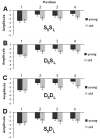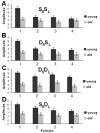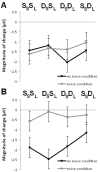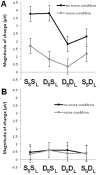Age differences in the neuroelectric adaptation to meaningful sounds
- PMID: 23935900
- PMCID: PMC3723892
- DOI: 10.1371/journal.pone.0068892
Age differences in the neuroelectric adaptation to meaningful sounds
Abstract
Much of what we know regarding the effect of stimulus repetition on neuroelectric adaptation comes from studies using artificially produced pure tones or harmonic complex sounds. Little is known about the neural processes associated with the representation of everyday sounds and how these may be affected by aging. In this study, we used real life, meaningful sounds presented at various azimuth positions and found that auditory evoked responses peaking at about 100 and 180 ms after sound onset decreased in amplitude with stimulus repetition. This neural adaptation was greater in young than in older adults and was more pronounced when the same sound was repeated at the same location. Moreover, the P2 waves showed differential patterns of domain-specific adaptation when location and identity was repeated among young adults. Background noise decreased ERP amplitudes and modulated the magnitude of repetition effects on both the N1 and P2 amplitude, and the effects were comparable in young and older adults. These findings reveal an age-related difference in the neural processes associated with adaptation to meaningful sounds, which may relate to older adults' difficulty in ignoring task-irrelevant stimuli.
Conflict of interest statement
Figures







Similar articles
-
Aging Affects Adaptation to Sound-Level Statistics in Human Auditory Cortex.J Neurosci. 2018 Feb 21;38(8):1989-1999. doi: 10.1523/JNEUROSCI.1489-17.2018. Epub 2018 Jan 22. J Neurosci. 2018. PMID: 29358362 Free PMC article.
-
Cortical auditory evoked potential in aging: effects of stimulus intensity and noise.Otol Neurotol. 2012 Sep;33(7):1105-12. doi: 10.1097/MAO.0b013e3182659b1e. Otol Neurotol. 2012. PMID: 22892802
-
Two-stage processing of sounds explains behavioral performance variations due to changes in stimulus contrast and selective attention: an MEG study.PLoS One. 2012;7(10):e46872. doi: 10.1371/journal.pone.0046872. Epub 2012 Oct 11. PLoS One. 2012. PMID: 23071654 Free PMC article. Clinical Trial.
-
Varying effect of noise on sound onset and acoustic change evoked auditory cortical N1 responses evoked by a vowel-vowel stimulus.Int J Psychophysiol. 2020 Jun;152:36-43. doi: 10.1016/j.ijpsycho.2020.04.010. Epub 2020 Apr 14. Int J Psychophysiol. 2020. PMID: 32302643
-
Perceptual demand modulates activation of human auditory cortex in response to task-irrelevant sounds.J Cogn Neurosci. 2013 Sep;25(9):1553-62. doi: 10.1162/jocn_a_00416. Epub 2013 May 6. J Cogn Neurosci. 2013. PMID: 23647558 Free PMC article.
Cited by
-
Neural Correlates of Speech Segregation Based on Formant Frequencies of Adjacent Vowels.Sci Rep. 2017 Jan 19;7:40790. doi: 10.1038/srep40790. Sci Rep. 2017. PMID: 28102300 Free PMC article.
-
Aging Enhances Neural Activity in Auditory, Visual, and Somatosensory Cortices: The Common Cause Revisited.J Neurosci. 2022 Jan 12;42(2):264-275. doi: 10.1523/JNEUROSCI.0864-21.2021. Epub 2021 Nov 12. J Neurosci. 2022. PMID: 34772740 Free PMC article.
-
Effects of Noise on the Behavioral and Neural Categorization of Speech.Front Neurosci. 2020 Feb 27;14:153. doi: 10.3389/fnins.2020.00153. eCollection 2020. Front Neurosci. 2020. PMID: 32180700 Free PMC article.
-
Responses to Predictable versus Random Temporally Complex Stimuli from Single Units in Auditory Thalamus: Impact of Aging and Anesthesia.J Neurosci. 2016 Oct 12;36(41):10696-10706. doi: 10.1523/JNEUROSCI.1454-16.2016. J Neurosci. 2016. PMID: 27733619 Free PMC article.
-
Neural correlates of auditory sensory memory dynamics in the aging brain.Neurobiol Aging. 2020 Apr;88:128-136. doi: 10.1016/j.neurobiolaging.2019.12.020. Epub 2019 Dec 30. Neurobiol Aging. 2020. PMID: 32035848 Free PMC article.
References
-
- Budd TW, Barry RJ, Gordon E, Rennie C, Michie PT (1998) Decrement of the N1 auditory event-related potential with stimulus repetition: habituation vs. refractoriness. Int J Psychophysiol 31: 51-68. doi:10.1016/S0167-8760(98)00040-3. PubMed: 9934621. - DOI - PubMed
-
- Grill-Spector K, Henson R, Martin A (2006) Repetition and the brain: neural models of stimulus-specific effects. Trends Cogn Sci 10: 14-23. doi:10.1016/j.tics.2005.11.006. PubMed: 16321563. - DOI - PubMed
-
- Delgutte B (1997) Auditory neural processing of speech. In: Hardcastle WJ, Laver J, The handbook of phonetic sciences. Oxford: Blackwell Publishing House; pp 507-538.
-
- Shore SE (1995) Recovery of forward-masked responses in ventral cochlear nucleus neurons. Hear Res 82: 31-43. doi:10.1016/0378-5955(94)00160-R. PubMed: 7744711. - DOI - PubMed
-
- Fitzpatrick DC, Kuwada S, Kim DO, Parham K, Batra R (1999) Responses of neurons to click-pairs as simulated echoes: auditory nerve to auditory cortex. J Acoust Soc AM 106: 3460-3472. doi:10.1121/1.428199. PubMed: 10615686. - DOI - PubMed
Publication types
MeSH terms
Grants and funding
LinkOut - more resources
Full Text Sources
Other Literature Sources

